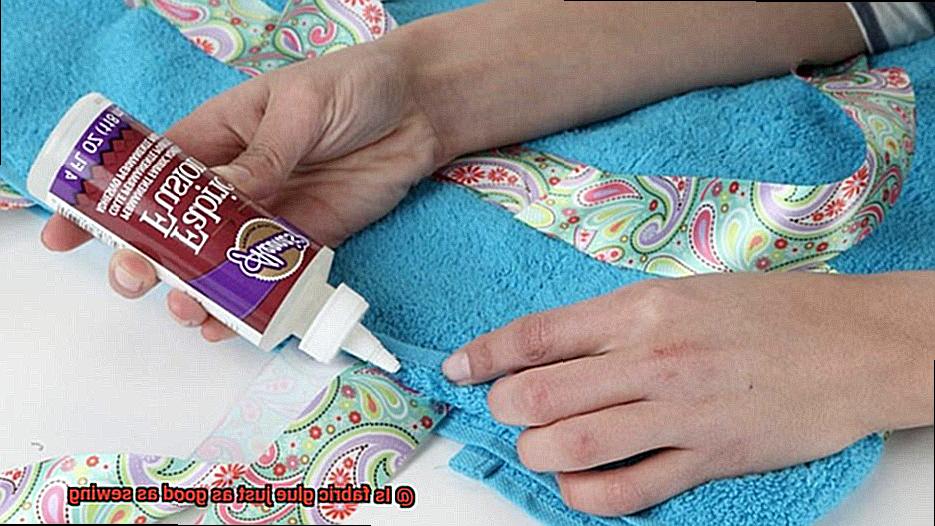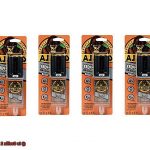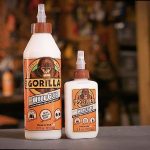Joining fabric has always sparked a lively debate: is fabric glue really as good as sewing? Some swear by the tried-and-true needle and thread, while others champion the wonders of fabric glue. As an experienced craftsperson immersed in the world of fabric arts, I’ve explored both techniques extensively. In this blog post, we’ll dive into durability, cost, and time to shed light on this age-old question.
Durability:
Contents
Sewing has long been hailed as the gold standard for fabric assembly due to its unwavering durability. Those interlocking stitches create an unbreakable bond that stands up to years of wear and tear. Fabric glue, on the other hand, relies on adhesive properties to hold things together. While it works wonders for smaller projects, it may struggle when faced with heavy-duty usage over time. However, recent advancements in fabric glue technology are narrowing the gap in durability.
Cost:
When it comes to cost-effectiveness, fabric glue often steals the show. Sewing requires investing in a sewing machine along with threads, needles, and various supplies. On the flip side, fabric glue is budget-friendly and requires minimal upfront investment. Plus, sewing machines may need occasional maintenance or repairs whereas fabric glue is a one-time purchase. So if you’re watching your wallet closely, fabric glue might just be your saving grace.
Time:
In terms of efficiency, fabric glue takes the lead without breaking a sweat. Sewing can be a time-consuming process—especially for intricate designs or delicate fabrics—requiring patience and precision. Fabric glue allows for quick and effortless bonding with just a few well-placed dabs. No need for intricate stitching. So if you’re working on a project with tight deadlines or simple designs, fabric glue will save you precious hours.

Balance is Key:
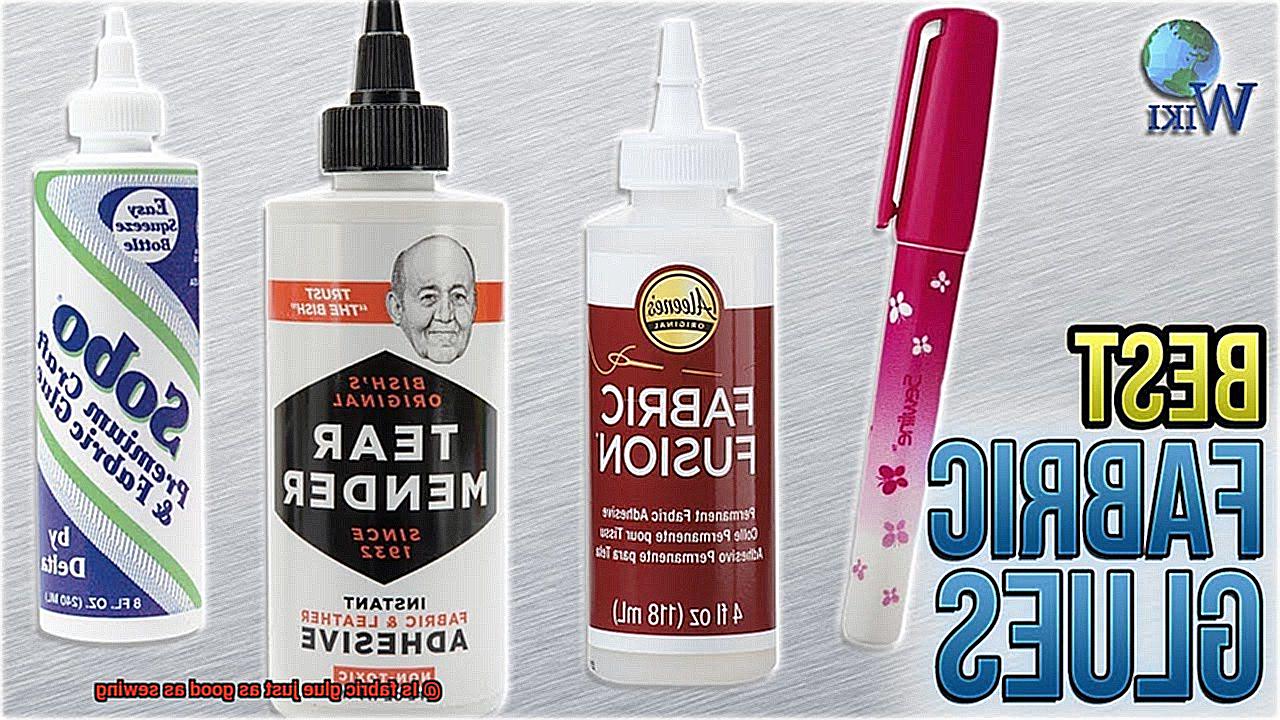
To sum it all up, the fabric glue vs. sewing debate doesn’t have a clear winner. Each method has its own strengths and weaknesses, and the choice ultimately depends on your project’s specific needs. Sewing guarantees unmatched longevity and reliability, making it perfect for heavy-duty fabrics and projects. Meanwhile, fabric glue shines in terms of cost-effectiveness and time efficiency, proving to be a valuable tool for certain applications.
So if you find yourself torn between fabric glue and sewing, consider factors like durability, cost, and time to make an informed decision that suits your unique project requirements.
Advantages of Fabric Glue
When it comes to fabric-related projects, sewing has long been the go-to method for bonding materials together. However, fabric glue has emerged as a convenient and versatile alternative that offers several advantages over traditional sewing methods. In this article, we will explore the benefits of using fabric glue, its various types, and how it compares to sewing in terms of cost, time saved, and quality of results.
Advantages of Fabric Glue:
- Ease of Use: Fabric glue is incredibly simple to use, making it a great option for individuals who may not have sewing skills or access to a sewing machine. With fabric glue, you can easily apply the adhesive directly onto the fabric, press the pieces together, and let it dry. It eliminates the need for needle and thread, making it accessible to beginners and a time-saving option for quick repairs.
- Time-saving: Fabric glue saves a significant amount of time compared to sewing. Sewing can be a time-consuming process, especially when dealing with intricate designs or multiple layers of fabric. Fabric glue allows for quick and efficient bonding, eliminating the need for stitching each individual seam. This is particularly beneficial for time-sensitive projects or when you need to make quick alterations.
- Versatility: Fabric glue offers great versatility in terms of the materials it can bond together. Unlike traditional sewing, which is limited to fabrics and threads, fabric glue can be used to adhere various types of materials such as leather, felt, sequins, beads, and even non-fabric items like buttons or ribbons. This makes it an excellent choice for embellishing garments, creating crafts, or adding decorative elements to different surfaces.
- Strength and Durability: When used correctly, fabric glue can provide a strong and durable bond between fabrics. Modern fabric glues are designed to withstand regular wear and tear, making them suitable for both temporary fixes and long-term projects. It is important to select a high-quality fabric glue that is specifically formulated for the type of material you are working with to ensure optimal strength and durability.
- Invisible Bonding: Fabric glue can create seamless and almost invisible bonds between fabrics. Unlike visible stitching lines that may alter the appearance of the finished product, fabric glue allows for smooth and inconspicuous adhesion. This is particularly advantageous when working on delicate or lightweight fabrics where visible stitches may cause damage or compromise the overall aesthetics.
- Washability: Many fabric glues are designed to withstand washing and dry cleaning, ensuring that the bond remains intact even after multiple laundry cycles. This makes it suitable for attaching patches, appliques, or repairing garments that require regular cleaning. It is important to check the label of the fabric glue to confirm its washability and follow any specific instructions provided by the manufacturer.
Strength of the Bond
The strength of the bond between fabric glue and sewing is influenced by various factors. Fabric glue, a magical adhesive designed for bonding fabrics together, forms a strong connection by adhering to the fibers of the fabric. However, the type of fabric being used can impact the strength of the bond. Fabrics with smoother surfaces, such as cotton or polyester, tend to form stronger bonds with fabric glue. Conversely, fabrics with rough or textured surfaces, like denim or corduroy, may not bond as well.
Additionally, how the glue is applied is crucial for a strong bond. Even and sufficient application of the glue is necessary to avoid gaps or unevenness that could weaken the bond. Following the manufacturer’s instructions and allowing enough time for the glue to dry and set is also important.
Sewing, on the other hand, creates a bond by interlocking the threads of the fabric. The type of stitch used in sewing plays a significant role in the strength of the bond. Reinforced stitches like backstitch or lockstitch provide stronger bonds compared to basic straight stitches. The quality of the thread used for sewing is also important. High-quality threads that are strong and resistant to breakage will result in stronger bonds. Additionally, maintaining proper tension of the thread and ensuring tight stitches contribute to the strength of the bond.
In general, sewing tends to create stronger bonds compared to fabric glue due to its interlocking nature. This method provides a more secure and long-lasting connection between fabric layers. However, fabric glue has its place in certain situations. It can be an excellent option for projects or fabrics that are not suitable for sewing, as well as for lighter applications or temporary fixes.
Aesthetic Appeal
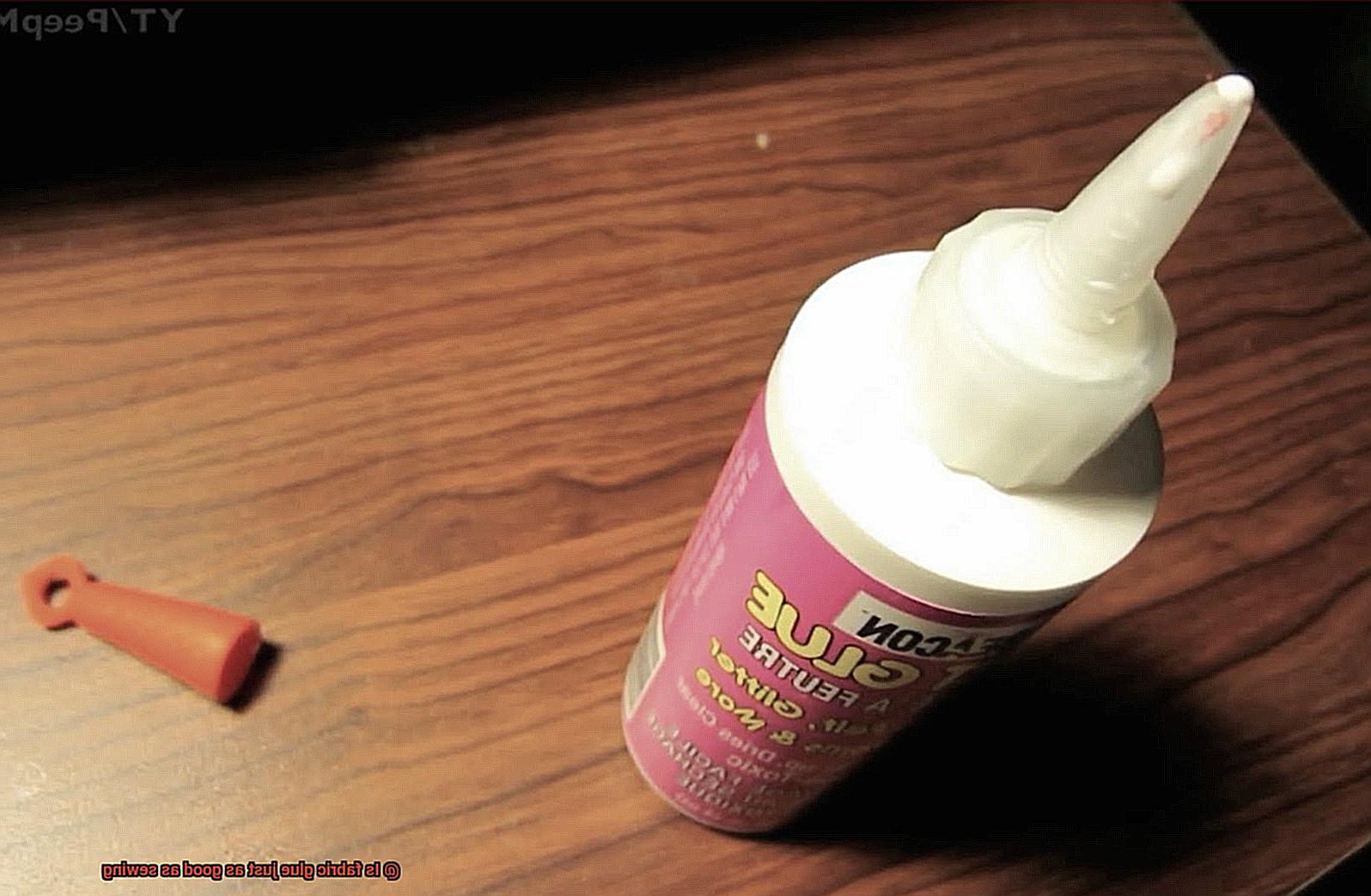
Today, we’re going to explore how sewing can take your projects to a whole new level of aesthetic appeal. So grab your thread and needle, because we’re about to unlock the secrets of visual beauty.
When it comes to aesthetics, sewing offers a level of precision and control that fabric glue simply can’t match. Imagine having the power to create intricate details and embellishments that elevate your project from ordinary to extraordinary. With sewing, you can choose from a variety of decorative stitching techniques, such as embroidery or appliqué, adding that extra touch of visual appeal that sets your creation apart.
But wait, there’s more. Fabric glue may seem like a quick fix, but it often falls short in delivering the same level of finesse and attention to detail. The bond created by glue can sometimes leave behind visible residue or marks that detract from your overall aesthetic. Who wants that, right?
One of the most significant advantages of sewing is its flexibility. Need to adjust or modify your design? No problem. With a few stitches here and there, you can easily make alterations on the fly, giving you the freedom to fully explore your creativity. On the other hand, fabric glue limits your ability to make changes once it’s applied – kind of like getting a bad haircut and desperately wishing for a time machine.
Now, let’s talk longevity. When it comes to durability, sewing takes the crown. The interlocking nature of stitches creates a bond that can withstand the test of time. Reinforced stitches like backstitch or lockstitch provide superior strength compared to basic straight stitches. It’s like having an unbreakable bond between two lovers – except in this case, it’s your fabric layers.
Of course, we don’t want to discredit fabric glue entirely. It has its place in certain situations, like when sewing may not be suitable for the project or fabric. It can also come in handy for lighter applications or temporary fixes where speed and convenience are key. Think of it as the reliable sidekick to your sewing superhero.
So, whether you’re a seasoned sewing pro or just starting out on your creative journey, remember the power of aesthetics lies in your hands – or should I say, in your stitches. Embrace the art of sewing and unlock a world of endless possibilities. Your projects will thank you for it, and you’ll be amazed at the level of aesthetic appeal you can achieve.
Projects Not Suitable for Fabric Glue
Today, let’s delve into the world of fabric glue and uncover its limitations. While fabric glue is a handy tool for many projects, there are certain situations where sewing reigns supreme. So, let’s explore why fabric glue may not be suitable for heavy-weight fabrics, high-tension seams, structural projects, delicate fabrics, and those that require longevity.
First and foremost, heavy-weight fabrics like denim or upholstery fabrics demand the strength and stability that only sewing can provide. The weight of these fabrics puts immense stress on glue bonds, often causing them to weaken or fail over time. When it comes to heavy-duty materials, sewing is the heavyweight champion.
Speaking of stress, high-tension seams need the extra reinforcement that sewing offers. Fitted garments or items that will be subjected to pulling or stretching are better suited for sewing. Fabric glue simply may not withstand the pressure and strain, resulting in a bond that easily unravels.
Now let’s turn our attention to structural projects. Whether you’re constructing bags or upholstering furniture, sewing is essential. Fabric glue alone lacks the necessary strength and durability to securely hold these pieces together. For sturdy and reliable connections, sewing is the go-to method.
Moving on to delicate fabrics – while fabric glue can work well with many types of delicate materials, caution should be exercised. Some delicate fabrics, like silk or chiffon, may react poorly to the chemicals in fabric glue or have sensitivity issues. In these cases, using a needle and thread to sew delicate fabrics proves to be a safer option.
Last but not least, if you want your projects to stand the test of time, sewing is generally the better choice. Fabric glue may deteriorate over time due to exposure to heat, moisture, or repeated washing. Sewing provides a more permanent and durable bond that can withstand regular use and washing without compromising your project’s integrity.
Adjustability
When it comes to the world of textiles and crafting, the question of adjustability often arises. Whether you’re a seasoned DIY enthusiast or just dipping your toes into the creative waters, understanding the concept of adjustability is crucial. It can be the difference between a perfectly tailored garment and a project that falls flat.
In the realm of adjustability, sewing reigns supreme. The art of sewing grants you the power to make precise and customizable adjustments to your creations. Need to shorten a hemline? No problem. Want to take in a waistline for a better fit? Consider it done. Sewing allows for easy alterations, giving you control over every stitch and making changes as needed.
On the flip side, fabric glue fails to offer the same level of adjustability. Once that adhesive is applied and dried, it becomes permanent and difficult to undo. Mistakes or changes become a daunting task, potentially leading to irreversible damage to your fabric. Fabric glue is best suited for projects that don’t require frequent adjustments or alterations.
Durability is another factor where sewing takes the lead. Stitches create strong bonds between fabrics, capable of withstanding repeated wear and washing. On the contrary, fabric glue may not hold up as well over time, putting your garments or projects at risk of falling apart.
Now, let’s talk about cost. Sewing may require an initial investment in a sewing machine, needles, thread, and other supplies. However, once you have these tools in your creative arsenal, they can be utilized for multiple projects over an extended period. Fabric glue tends to be more affordable upfront but may need to be replenished more frequently if you frequently work on textile projects.
Ease of use is another consideration where fabric glue shines. It’s particularly beginner-friendly and ideal for those without access to a sewing machine. Simply apply the glue and press the fabric together—no extensive setup required. Sewing demands more skill and practice to achieve clean and professional-looking stitches.
Control is yet another area where sewing comes out on top. With sewing, you have complete control over the placement of stitches and can adjust tension as needed. Fabric glue, while easy to use, may not provide the same level of precision, especially when working with intricate details or small pieces.
Factors to Consider When Choosing Between Sewing and Glue
Choosing between sewing and glue for fabric crafts and projects can be a daunting decision. Each method has its own advantages and limitations, so it’s important to consider several key factors when making your choice. This article will explore factors such as durability, flexibility, time and convenience, skill level, and reversibility. By understanding these factors, you’ll be able to select the method that best suits your project’s needs.
Durability:
Consider the durability of the bond when deciding between sewing and glue. Sewing creates a strong and secure connection between fabrics, ideal for items like clothing or bags that will undergo regular use and washing. Fabric glue may not provide the same level of durability, especially for items that will experience stress or tension. Think about the intended use of the fabric item and choose the method that will result in a bond strong enough to withstand the required wear and tear.
Flexibility:
Another factor to consider is the flexibility of the fabric. Sewing allows for greater flexibility as it creates small punctures or stitches in the fabric, enabling it to move and stretch without compromising the bond. Glue can sometimes create a stiff or rigid connection between fabrics, limiting their flexibility. This is particularly important for garments or accessories that require movement or stretch.
Time and Convenience:
Time and convenience are important factors to consider. Sewing can be time-consuming, especially for beginners or those without access to a sewing machine. It involves setting up the machine, threading the needle, stitching along desired seams, and finishing off edges. Fabric glue offers a quicker and more convenient alternative. It requires minimal setup and can be applied directly to the fabric, saving time and effort. If time is a critical factor or if you need a temporary solution, fabric glue may be more suitable.
Skill Level:
Consider your skill level when choosing between sewing and glue. Sewing typically requires some level of skill and experience to achieve professional-looking results. It involves knowledge of stitching techniques, thread tension, and fabric handling. Fabric glue can be used by individuals with little to no sewing experience. It provides a simple and straightforward method of bonding fabrics without the need for intricate stitching. If you’re a beginner or lack sewing skills, fabric glue can be a great alternative for simple projects or quick fixes.
Reversibility:
The reversibility of the bond is another important factor to consider. Sewing creates a permanent connection between fabrics, making it difficult to undo or alter seams once they are stitched. Fabric glue offers more flexibility in terms of reversibility. In some cases, fabric glue can be dissolved or softened with heat, allowing fabrics to be separated and repositioned if needed. This is advantageous for temporary projects or when adjustments may need to be made in the future.
Testing the Compatibility of Fabric Glue
Fabric glue has revolutionized the world of fabric crafts, offering convenience, speed, and versatility. But not all fabric glues are created equal, and testing their compatibility is the key to ensuring strong bonds and lasting results. In this section, we will dive into the fascinating process of testing fabric glue for compatibility, exploring factors such as adhesive strength, durability, compatibility with embellishments and sewing techniques, and the power of user feedback.
Adhesive Strength:
To unleash the full potential of fabric glue, it’s essential to assess its adhesive strength. Apply the glue to a variety of fabric samples, letting them dry completely. Then, embark on a thrilling tug-of-war by pulling the fabric apart. This simple yet effective test will determine if the glue wields its power consistently across different fabrics, guaranteeing reliable results every time.
Durability:
The true test of fabric glue lies in its ability to withstand the trials of time. To gauge its durability, subject your glued fabric samples to a series of arduous stress tests. Bend them like a contortionist, stretch them like an Olympic gymnast, or even wash them with abandon. Witness firsthand how well the glue holds up under these relentless trials. Only then can you confidently create projects that stand tall against the wear and tear of everyday life.
Compatibility with Embellishments:
For those who crave the sparkle and dazzle of embellishments on their fabric projects, testing the compatibility of fabric glue becomes a glitter-filled adventure. Apply the glue to a sample fabric adorned with sequins or beads and watch closely for any signs of damage or transformation. This step ensures that your creations shine bright without sacrificing their integrity.
Compatibility with Sewing Techniques:
Why settle for one when you can have both? Combining sewing and gluing techniques can elevate your fabric projects to new heights. But beware of the glue that threatens to unravel your sewing dreams. Test the glue on fabric samples destined for the needle and thread, assessing if it hampers the sewing process or weakens the very fabric of your creation. Strike the perfect balance between strength and elegance, seamlessly merging two worlds.
User Feedback:
The power of collective wisdom cannot be underestimated. Seek guidance from fellow crafters who have embarked on their own journeys with fabric glue. Unearth a treasure trove of experiences, insights, and honest feedback. Online reviews, forums, and social media groups dedicated to crafting are rich sources of knowledge that can guide you towards the glue that unlocks your creative potential.
mORL1jJSdlk” >
Conclusion
Fabric glue may seem like a convenient alternative to sewing, but it falls short in many ways. While it can be useful for quick fixes or temporary solutions, it lacks the durability and strength that sewing provides. Sewing creates secure and long-lasting bonds between fabric pieces, ensuring that your creations withstand the test of time. On the other hand, fabric glue can weaken over time, leading to loose seams or even complete disintegration.
Furthermore, sewing allows for greater flexibility and precision in creating intricate designs. With a needle and thread, you have full control over every stitch, allowing you to tailor your projects exactly as you envision them. Fabric glue, on the other hand, can be messy and imprecise, making it difficult to achieve the same level of detail.
Additionally, sewing offers more versatility when it comes to fabric choices. While fabric glue may work well with certain types of fabrics, it may not adhere properly or create unsightly stains on others. Sewing allows you to seamlessly work with a wide range of materials without worrying about compatibility issues.
Moreover, sewing provides a sense of craftsmanship and personal touch that fabric glue simply cannot replicate. The act of stitching by hand or using a sewing machine requires skill and attention to detail, resulting in a finished product that exudes quality and professionalism. This level of care and dedication is often lacking when relying solely on fabric glue.
In conclusion, while fabric glue can serve as a quick fix or temporary solution in some cases, it cannot compare to the strength, durability, precision, versatility, and craftsmanship provided by sewing.

